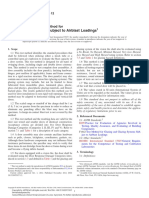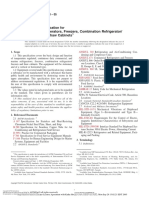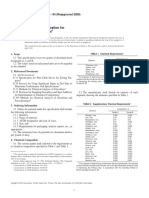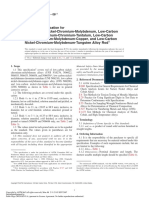Astm F 7
Astm F 7
Uploaded by
Maki Salim HussainCopyright:
Available Formats
Astm F 7
Astm F 7
Uploaded by
Maki Salim HussainOriginal Title
Copyright
Available Formats
Share this document
Did you find this document useful?
Is this content inappropriate?
Copyright:
Available Formats
Astm F 7
Astm F 7
Uploaded by
Maki Salim HussainCopyright:
Available Formats
Designation: F 7 – 95 (Reapproved 2000)
Standard Specification for
Aluminum Oxide Powder 1
This standard is issued under the fixed designation F 7; the number immediately following the designation indicates the year of original
adoption or, in the case of revision, the year of last revision. A number in parentheses indicates the year of last reapproval. A superscript
epsilon (e) indicates an editorial change since the last revision or reapproval.
1. Scope TABLE 1 Chemical Requirements
1.1 This specification covers aluminum oxide (alumina) Composition, %
Element or Compound
powder in two classes of particle size, two chemical grades, Grade 1 Grade 2
and two levels of acidity, for use as an insulating coating or as Alumina (Al2O3), min 99.65 99.65
an ingredient of ceramic mixtures for components of electronic Silica (SiO2), max 0.03 0.12
Magnesia (MgO), max 0.02 0.01
devices as follows: Ferric oxide (Fe2O3), max 0.04 0.04
1.1.1 Particle Sizes: Total alkali (as Na2O), max 0.04 0.04
1.1.1.1 Class A—Particle size No. 500 nominal mesh Carbon (C), max 0.01 0.01
Calcium oxide (CaO), max 0.02 0.01
(nominal average particle size = 24.3 µm). Zirconium oxide (ZrO2), max 0.01 0.01
1.1.1.2 Class B—Particle size No. 900 nominal mesh Boron (B), max 0.001 0.002
(nominal average particle size = 1.7 µm). Gallium oxide (Ga2O3), max 0.3
No other single metallic impurity 0.02 0.02
1.1.2 Chemical Grades—Grades 1 and 2 as specified under to exceed
chemical requirements in Section 3. Composition, ppm
1.1.3 Acidity Levels: pH (acid) 4.5 to 6.5 and pH (neutral) Water-soluble matter (as NaCl), max 300 300
6.5 to 7.5.
1.2 The following safety hazards caveat pertains only to the
test methods in this specification. This standard does not 5. Sampling
purport to address all of the safety concerns, if any, associated 5.1 Each lot of alumina shall be properly sampled in
with its use. It is the responsibility of the user of this standard accordance with standard techniques, such as Practice C 183.
to establish appropriate safety and health practices and
determine the applicability of regulatory limitations prior to 6. Test Methods
use. 6.1 Water-Soluble Content:
--```,,,``,,`,`,,`,`,`,`,`,`-`-`,,`,,`,`,,`---
6.1.1 Procedure—Determine the total water-soluble content
2. Referenced Documents
by measuring the electrical conductivity of a 100-mL distilled
2.1 ASTM Standards: or deionized water extract from a 5-g sample of alumina.
C 183 Practice for Sampling and the Amount of Testing of Elutriate by vigorously shaking the alumina suspension in a
Hydraulic Cement 2 flask for 1 to 2 min, allowing the solids to settle and decanting
E 70 Test Method for pH of Aqueous Solutions with the the clear supernatant liquid after 60 min. Measure the conduc-
Glass Electrode 3 tivity of the liquid with a standard cell and bridge. Correct this
measurement for the “blank” reading on a similarly treated
3. Chemical Composition
equal volume of the same pure water. Convert the net increase
3.1 For a specified particle size and level of acidity, the in conductivity of the water extract first to parts of water-
aluminum oxide shall conform to the requirements of Table 1 soluble content as sodium chloride (NaCl) per million parts of
as to chemical composition. water (factor is 1 micromho = 0.5 ppm NaCl), then relate to the
actual weight of elutriated alumina. For example, on a typical
4. Physical Properties
100-mL extract 10 micromhos (net) or 5 parts of NaCl per
4.1 The alumina shall be “chalk white,” dry, free from million of water in this volume of liquid is equivalent to 100
lumps, and of particle size distribution as agreed upon between parts of NaCl per million of alumina on the basis of a 5-g
purchaser and seller. sample.
6.1.2 Calculation— Determine the parts per million of
1
This specification is under the jurisdiction of ASTM Committee F1 on water-soluble content as follows:
Electronics and is the direct responsibility of Subcommittee F01.03 on Metallic
7
Materials. ppm 5 10 Kc@~Rb 2 R x! /RbRx # (1)
Current edition approved Nov. 10, 1995. Published January 1996. Originally
published as F 7 – 58 T. Last previous edition F 7 – 70 (1991). where:
2
Annual Book of ASTM Standards, Vol 04.01.
3 Kc = cell constant, cm −1,
Annual Book of ASTM Standards, Vol 15.05.
Copyright © ASTM, 100 Barr Harbor Drive, West Conshohocken, PA 19428-2959, United States.
Copyright ASTM International
1
Reproduced by IHS under license with ASTM Licensee=Bechtel Corp/9999056100
No reproduction or networking permitted without license from IHS Not for Resale, 08/29/2005 23:50:04 MDT
F7
Rb = specific resistance of test water, V·cm, and TABLE 3 50 % Point Results of Particle Size Distribution
Analysis on Typical Material—Diameter in Micrometers A , B
Rx = specific resistance of alumina extract in test water,
V·cm. Method
Material (Class—Grade)†
6.2 Particle Size: A-1 A-2 B-1 B-2
6.2.1 Determine particle size distribution by any of the Sharples Micromerograph 13.2 6.2 5.1 4.8
following methods: (a) Coulter counter, (b) M.S.A. centrifuge Cahn Sedimentometer 15.5 7.0 4.7 4.7
M.S.A. centrifuge 14.0 7.1 4.2 4.2
method, (c) Cahn Sedimentometer, or (d) Sharples Micromer- Coulter counter 17.1 8.1 6.6 5.2
ograph. A
From Subcommittee I round-robin test results—Nov. 8, 1967.
B
Variations between laboratories should not exceed 3 % on similar instruments.
NOTE 1—Procedures for determining particle size by the methods † Editorally corrected.
shown in Table 2 are described in the operating manuals of the equipment
listed.
6.2.2 Number average particle size may be taken as the 6.3.1 Weigh out 20 g of the sample and transfer to a clean
50 % point on the particle size distribution curve or may be 100-mL beaker. Add 20 mL of distilled or deionized water and
measured by the Fisher sub-sieve sizer. make into a slurry using a clean stirring rod. Stir for 1 to 2 min.
6.2.3 A density of 3.97 g/cm3 for aluminum oxide will be Wash electrodes thoroughly with distilled or deionized water,
used in all calculations. remix slurry, immerse electrodes into slurry approximately 6 to
6.2.4 Particle size distribution of acceptable material in both 12 mm, and measure pH in accordance with Test Method E 70.
Class A and Class B will be by agreement between purchaser 6.3.2 Any weight of slurry in the above ratio may be used
and seller. Sample size and method of dispersion will be provided there is sufficient slurry to immerse electrodes to the
identical in all test correlations, as specified in Table 2. Typical proper depth.
results are shown in Table 3. 6.3.3 Wash electrodes immediately after using with several
6.2.5 Number average particle size of acceptable material in hundred millilitres of distilled or deionized water, removing the
both Class A and Class B will be by agreement between adhered slurry with the aid of a pipe cleaner. It is important for
purchaser and seller. accuracy to prevent buildup of the slurry on the electrodes.
6.2.6 Complete dispersion of samples is essential and rec-
ommended procedure in Table 2 shall be followed. 7. Keywords
6.3 Hydrogen-Ion Concentration (pH): 7.1 alumina; particle sizing methods; powder
TABLE 2 Requirements for Sample Sizes and Dispersing Agents
Sample
Sample Dispersing
Method Concentration Dispersing Agent
Size, g Medium
Weight%
Coulter counter A 0.25 0.1 methanol LiCl-38g/gal
M.S.A. centrifuge 1.0 0.03 H2O Na2SiO3 to pH = 10.5
Cahn Sedimentometer 0.4 0.03 H2O 0.1 % Na2P4O7
Sharples Micromerograph 0.06 N2 none
A
The instrument manufacturer recommends the following: sample size—0.0025 g, sample concentration—0.001 weight % , dispersing medium—0.9 % NaCl in H2O,
and dispersing agent—0.1 % Na2P4O7.
The American Society for Testing and Materials takes no position respecting the validity of any patent rights asserted in connection
with any item mentioned in this standard. Users of this standard are expressly advised that determination of the validity of any such
patent rights, and the risk of infringement of such rights, are entirely their own responsibility.
This standard is subject to revision at any time by the responsible technical committee and must be reviewed every five years and
if not revised, either reapproved or withdrawn. Your comments are invited either for revision of this standard or for additional standards
and should be addressed to ASTM Headquarters. Your comments will receive careful consideration at a meeting of the responsible
technical committee, which you may attend. If you feel that your comments have not received a fair hearing you should make your
views known to the ASTM Committee on Standards, at the address shown below.
This standard is copyrighted by ASTM, 100 Barr Harbor Drive, PO Box C700, West Conshohocken, PA 19428-2959, United States.
Individual reprints (single or multiple copies) of this standard may be obtained by contacting ASTM at the above address or at
610-832-9585 (phone), 610-832-9555 (fax), or service@astm.org (e-mail); or through the ASTM website (www.astm.org).
--```,,,``,,`,`,,`,`,`,`,`,`-`-`,,`,,`,`,,`---
Copyright ASTM International
2
Reproduced by IHS under license with ASTM Licensee=Bechtel Corp/9999056100
No reproduction or networking permitted without license from IHS Not for Resale, 08/29/2005 23:50:04 MDT
You might also like
- ASTM F2927 Standard Method For Doors Sustems Subjected To Air Blast LoadingDocument11 pagesASTM F2927 Standard Method For Doors Sustems Subjected To Air Blast LoadingMaki Salim Hussain50% (4)
- ASTM E1251 2017 Ver A PDFDocument10 pagesASTM E1251 2017 Ver A PDFaizaz65No ratings yet
- ASTM D-520 (Standard Speci Cation For Zinc Dust Pigment)Document2 pagesASTM D-520 (Standard Speci Cation For Zinc Dust Pigment)Moeen Iqbal Shah100% (1)
- D4185Document8 pagesD4185Fredi Cari CarreraNo ratings yet
- Flue Gas Co CaptureDocument28 pagesFlue Gas Co CaptureVlad LaskachNo ratings yet
- Chemical Composition ZincDocument3 pagesChemical Composition Zincchan channsreyrathNo ratings yet
- High-Strength Low-Alloy Structural Steel Plate With Low Carbon and Restricted Sulfur For Improved Weldability, Formability, and ToughnessDocument3 pagesHigh-Strength Low-Alloy Structural Steel Plate With Low Carbon and Restricted Sulfur For Improved Weldability, Formability, and ToughnessMarcelo BarretosNo ratings yet
- Astm F 2520-05Document6 pagesAstm F 2520-05Maki Salim HussainNo ratings yet
- Aluminum Oxide Powder: Standard Specification ForDocument2 pagesAluminum Oxide Powder: Standard Specification FordgkmurtiNo ratings yet
- Astm B333Document5 pagesAstm B333Jota JacquesNo ratings yet
- ASTM B 333 Ni-Mo Alloy Plate Sheet & Strip - 1998Document5 pagesASTM B 333 Ni-Mo Alloy Plate Sheet & Strip - 1998ecsuperalNo ratings yet
- A 481 - 94 R00 QTQ4MQDocument3 pagesA 481 - 94 R00 QTQ4MQdelta lab sangliNo ratings yet
- Nickel: Standard Specification ForDocument3 pagesNickel: Standard Specification ForAbid HussainNo ratings yet
- Amendment No. 3 December 2021 TO Is 209: 1992 Zinc Ingot - SpecificationDocument2 pagesAmendment No. 3 December 2021 TO Is 209: 1992 Zinc Ingot - Specificationvishal.shelareNo ratings yet
- SB 335Document6 pagesSB 335Yuvaraj SathishNo ratings yet
- ASTM B233 StandardDocument4 pagesASTM B233 StandardpurechemcabledeptNo ratings yet
- ASTMB932Document3 pagesASTMB932eng.usmanali2012No ratings yet
- Asme2b SB 446Document8 pagesAsme2b SB 446Marjan SubanNo ratings yet
- Wadi Cement Work Ordinary Portland Cement 53 Grade: Chemical CharacteristicsDocument1 pageWadi Cement Work Ordinary Portland Cement 53 Grade: Chemical CharacteristicsAshish SontakkeNo ratings yet
- Nuclear-Grade Aluminum Oxide Powder: Standard Specification ForDocument2 pagesNuclear-Grade Aluminum Oxide Powder: Standard Specification Formohammed ;arasnehNo ratings yet
- Nuclear-Grade Aluminum Oxide Powder: Standard Specification ForDocument2 pagesNuclear-Grade Aluminum Oxide Powder: Standard Specification ForOsama TaghlebiNo ratings yet
- Astm E3047-16Document15 pagesAstm E3047-16Ismail Tp100% (1)
- Astm A65Document3 pagesAstm A65ptnvnc1111No ratings yet
- B29 - 03 ISO StandDocument3 pagesB29 - 03 ISO StandRizwanNo ratings yet
- Chromium Metal: Standard Specification ForDocument3 pagesChromium Metal: Standard Specification ForCarlos Raul Caballero LeonNo ratings yet
- Astm E478 - 2008Document21 pagesAstm E478 - 2008iabbas636No ratings yet
- Ur W31rev3Document35 pagesUr W31rev3marazzak.na05No ratings yet
- En Nickel - Carbonyl Fraction DNK 0Document1 pageEn Nickel - Carbonyl Fraction DNK 0jaridehmohammad31No ratings yet
- Ur W31rev2Document44 pagesUr W31rev2miguelNo ratings yet
- Astm e 1251-2011Document10 pagesAstm e 1251-2011ERDA TPI REPORTNo ratings yet
- High-Strength, Low-Alloy Carbon, Manganese, Columbium, Vanadium Steel of Structural Quality With Improved Notch ToughnessDocument2 pagesHigh-Strength, Low-Alloy Carbon, Manganese, Columbium, Vanadium Steel of Structural Quality With Improved Notch ToughnessMytzy Godoy TapiaNo ratings yet
- Date.4th October, 2021 FCO No. 1648/2021: FCO - Electro COPPER CATHODE 99.99% Virgin, RUSSIAN ORIGIN - No.AAADocument2 pagesDate.4th October, 2021 FCO No. 1648/2021: FCO - Electro COPPER CATHODE 99.99% Virgin, RUSSIAN ORIGIN - No.AAAFattahNo ratings yet
- Astm A482.a482mDocument3 pagesAstm A482.a482mOS LaboratoryNo ratings yet
- SB 333Document8 pagesSB 333Yuvaraj SathishNo ratings yet
- ASTM E1251-11 Analysis of Aluminum Alloys by SpectrometryDocument10 pagesASTM E1251-11 Analysis of Aluminum Alloys by SpectrometryAlojz KajinicNo ratings yet
- Astm B 233 - 97 PDFDocument4 pagesAstm B 233 - 97 PDFAnderson Jair Velandia PiraquiveNo ratings yet
- A 618 - 01 Qtyxoc9bnje4tqDocument4 pagesA 618 - 01 Qtyxoc9bnje4tqLUISNo ratings yet
- Steel Bars, Alloy, Hot-Wrought, For Elevated Temperature or Pressure-Containing Parts, or BothDocument2 pagesSteel Bars, Alloy, Hot-Wrought, For Elevated Temperature or Pressure-Containing Parts, or BothRamesh MarimuthuNo ratings yet
- Magnesium Alloys Chap16-ShortDocument19 pagesMagnesium Alloys Chap16-ShortWika RatnasariNo ratings yet
- Steel Joint Bars, Low, Medium, and High Carbon (Non-Heat-Treated)Document3 pagesSteel Joint Bars, Low, Medium, and High Carbon (Non-Heat-Treated)matiullahNo ratings yet
- A 102 Â " 93 R00 QTEWMI1SRUQDocument4 pagesA 102 Â " 93 R00 QTEWMI1SRUQJoffre ValladaresNo ratings yet
- Astm E1251 17Document6 pagesAstm E1251 17Paulo Cacilha Gouvea Cacilha GouveaNo ratings yet
- Requerimientos ABS Pruebas MecanicasDocument7 pagesRequerimientos ABS Pruebas MecanicasGilberto ZamudioNo ratings yet
- Alluminium GradesDocument4 pagesAlluminium GradesAnjani kumarNo ratings yet
- Gray Iron Castings For Elevated Temperatures For Non-Pressure Containing PartsDocument2 pagesGray Iron Castings For Elevated Temperatures For Non-Pressure Containing PartsfaroukNo ratings yet
- ASTM B574 - 2006e1Document4 pagesASTM B574 - 2006e1Cesar ParadaNo ratings yet
- Astm D520-00 (2019)Document2 pagesAstm D520-00 (2019)Rodrigo PizarroNo ratings yet
- Elementales 2Document5 pagesElementales 2mblancolNo ratings yet
- 2012 Appendix C: Hydrogen QualityDocument3 pages2012 Appendix C: Hydrogen QualityMabrur ZanataNo ratings yet
- Aluminum Foil For CapacitorsDocument6 pagesAluminum Foil For CapacitorsJefferson Castro AriasNo ratings yet
- Abrasive Standard No. 3: SSPC: The Society For Protective CoatingsDocument6 pagesAbrasive Standard No. 3: SSPC: The Society For Protective CoatingsBodegaNo ratings yet
- Astm B860Document3 pagesAstm B860EvelynNo ratings yet
- E 945 - 96 Determination of Zinc in Zinc Ores and Concentrates byDocument4 pagesE 945 - 96 Determination of Zinc in Zinc Ores and Concentrates byJOSE ABADNo ratings yet
- Specification For Precipitation-Hardening Nickel Alloy Bars, Forgings, and Forging Stock For High-Temperature ServiceDocument9 pagesSpecification For Precipitation-Hardening Nickel Alloy Bars, Forgings, and Forging Stock For High-Temperature ServicerbagriNo ratings yet
- Asme Section Ii B SB-62Document2 pagesAsme Section Ii B SB-62Vania Navarro CárdenasNo ratings yet
- Ixom Product Specification Alum SolidDocument1 pageIxom Product Specification Alum SolidAbdul LatifNo ratings yet
- Analysis of Magnesium and Magnesium Alloys by Atomic Emission SpectrometryDocument9 pagesAnalysis of Magnesium and Magnesium Alloys by Atomic Emission SpectrometrySofia YuliNo ratings yet
- ASTM B954-07 Standard Practice For Analysis of Magnesium and Magnesium Alloys by Atomic Emission SpectrometryDocument9 pagesASTM B954-07 Standard Practice For Analysis of Magnesium and Magnesium Alloys by Atomic Emission SpectrometryJinsoo KimNo ratings yet
- Cromgard C21Document3 pagesCromgard C21Sonu KumarNo ratings yet
- A 1026 - 03 - QtewmjyDocument2 pagesA 1026 - 03 - QtewmjyAdrian GonzalezNo ratings yet
- Compendium of Atomic Alkali Resistant Optical Thin Films, Diffusion and Electrical Mobility in Diode Pumped Alkali Lasers (DPALs)From EverandCompendium of Atomic Alkali Resistant Optical Thin Films, Diffusion and Electrical Mobility in Diode Pumped Alkali Lasers (DPALs)No ratings yet
- T 295-92 SG or API Gravity of Liquid Asphalts by HydrometerDocument3 pagesT 295-92 SG or API Gravity of Liquid Asphalts by HydrometerMaki Salim HussainNo ratings yet
- Astm F 2519-05Document20 pagesAstm F 2519-05Maki Salim HussainNo ratings yet
- BS 7644-1-1993Document13 pagesBS 7644-1-1993Maki Salim HussainNo ratings yet
- Astm F 15Document7 pagesAstm F 15Maki Salim HussainNo ratings yet
- Astm F 16Document5 pagesAstm F 16Maki Salim HussainNo ratings yet
- Astm F 4Document2 pagesAstm F 4Maki Salim HussainNo ratings yet
- Sikagrout 215 PDFDocument2 pagesSikagrout 215 PDFMaki Salim HussainNo ratings yet
- Sikadur® - 52 PDFDocument2 pagesSikadur® - 52 PDFMaki Salim HussainNo ratings yet
- Astm F 14Document4 pagesAstm F 14Maki Salim HussainNo ratings yet
- Carbon Steel Forgings For Piping ApplicationsDocument5 pagesCarbon Steel Forgings For Piping ApplicationsMaki Salim HussainNo ratings yet
- Concure WB309: Water Based Concrete Curing CompoundDocument2 pagesConcure WB309: Water Based Concrete Curing CompoundMaki Salim HussainNo ratings yet
- Ferrovanadium: Standard Specification ForDocument3 pagesFerrovanadium: Standard Specification ForMaki Salim HussainNo ratings yet
- Ferrochromium: Standard Specification ForDocument3 pagesFerrochromium: Standard Specification ForMaki Salim HussainNo ratings yet
- Analytical Method Validation NutraceuticalsDocument6 pagesAnalytical Method Validation NutraceuticalsBhaskar NapteNo ratings yet
- CH Heat TransferDocument18 pagesCH Heat TransferVinayKumarNo ratings yet
- Cambridge International AS & A Level: Chemistry 9701/23Document12 pagesCambridge International AS & A Level: Chemistry 9701/23nmeghani325No ratings yet
- GF Chemical Resistance ChartDocument38 pagesGF Chemical Resistance ChartjswaiNo ratings yet
- Network Modeling of The U.S. Petrochemical IndustryDocument15 pagesNetwork Modeling of The U.S. Petrochemical IndustryFelipe TavaresNo ratings yet
- How Do Catalytic Converters Work - Explain That StuffDocument1 pageHow Do Catalytic Converters Work - Explain That StuffNopparat SvtNo ratings yet
- SPI Sizing EquationsDocument61 pagesSPI Sizing EquationsnwabukingzNo ratings yet
- Applied Physics Notes-Unit-2Document17 pagesApplied Physics Notes-Unit-2medhadhruthiNo ratings yet
- Bearing Capactiy of BoltDocument3 pagesBearing Capactiy of Bolthebiwir295No ratings yet
- Periodic Table With Several InfosDocument1 pagePeriodic Table With Several InfosBCLNo ratings yet
- JC2 (05/06) Physics Common Test 2006 Suggested Answers: Paper 1Document13 pagesJC2 (05/06) Physics Common Test 2006 Suggested Answers: Paper 1wangks1980No ratings yet
- Practice Test THREEDocument13 pagesPractice Test THREEHua Tran Phuong ThaoNo ratings yet
- Experiment 3 Hydraulics LabDocument12 pagesExperiment 3 Hydraulics LabMatt NashrudinNo ratings yet
- Instant Notes in Organic ChemistryDocument368 pagesInstant Notes in Organic ChemistryRini WulandariNo ratings yet
- Hora or How Days (Vaars) Are FormedDocument1 pageHora or How Days (Vaars) Are FormedRupam123No ratings yet
- Mid Term Paper Advanced Spectroscopic Techniques F-2022Document2 pagesMid Term Paper Advanced Spectroscopic Techniques F-2022AnumNo ratings yet
- General Wave Properties 1 MSDocument4 pagesGeneral Wave Properties 1 MSherawatiNo ratings yet
- Stirling CryocoolerDocument7 pagesStirling Cryocooler111Neha SoniNo ratings yet
- The Saturated Greenhouse Effect Theory of Ferenc MiskolcziDocument86 pagesThe Saturated Greenhouse Effect Theory of Ferenc MiskolcziDiannaCCNo ratings yet
- MAE 101C (Spring 2020) - Midterm Exam #2: Problem 1 (20 Points)Document1 pageMAE 101C (Spring 2020) - Midterm Exam #2: Problem 1 (20 Points)Dinger RectileNo ratings yet
- Dynamics (Work, Energy and Power)Document5 pagesDynamics (Work, Energy and Power)YadanaNo ratings yet
- Simulation of Ethanol Extractive Distillation With Mixed Glycols As Separating AgentDocument12 pagesSimulation of Ethanol Extractive Distillation With Mixed Glycols As Separating AgentViona WidyaNo ratings yet
- Phytochemical Screening Tests SartajDocument3 pagesPhytochemical Screening Tests SartajJarvis WillNo ratings yet
- Landfill Leachate TreatmentDocument93 pagesLandfill Leachate TreatmentZainab Jerecko100% (2)
- Note For EJU 12Document2 pagesNote For EJU 12mr.draungnaingwinNo ratings yet
- Solutions To Filtration 2015Document7 pagesSolutions To Filtration 2015Christine MañalongNo ratings yet
- Genset Data Sheets-5 EngineDocument2 pagesGenset Data Sheets-5 EngineEhsan BagheriNo ratings yet
- b1 Flows Fluctuations and ComplexityDocument79 pagesb1 Flows Fluctuations and ComplexityAndrew OrrNo ratings yet






































































































